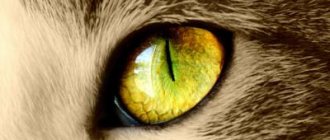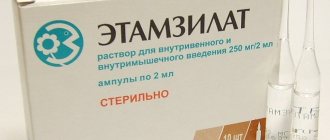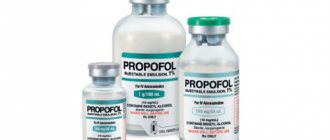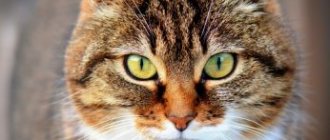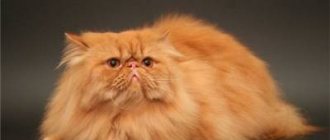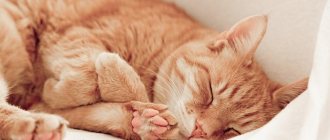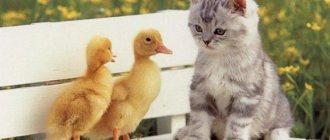Scottish Fold cats have fans all over the world: their small, downturned ears leave no one indifferent. But, unfortunately, it is precisely because of this feature that Scottish Folds are susceptible to osteochondrodysplasia. We will find out what this disease is, how it manifests itself, and we will also look at how to care for a sick cat, what to feed and how to treat it.
Description of the disease
Osteochondrodysplasia in cats (OCD or osteochondrodystrophy) is a genetic malformation of bones and cartilage that leads to slower growth and deformation.
Interesting! Translated from Greek, “osteo” means “bone,” and “dysplasia” means “developmental disorder.”
Osteochondrodysplasia most often affects Scottish Folds, since the disease is directly related to the gene for fold ears. Scots' downturned ears remain this way due to insufficient cartilage formation and disruption of its formation. The lop ear gene is responsible not only for ear deformation, but also for disruption of cartilage formation throughout the body.
Chondrodysplasia usually affects cats' limbs, thoracic, lumbar and caudal vertebrae. This disease can also manifest itself in the form of achondroplasia. With this disease, the cat’s paws cannot grow to normal size, so the pet develops dwarfism.
Osteochondrodysplasia is not life-threatening in most cases, but it can significantly reduce the quality and duration of life.
Causes
Osteochondrodysplasia in cats is inherited. Its manifestation is not related to the gender of the animal.
OCD is considered a disease of Scottish Fold cats, because they are the owners of a mutant gene for fold ears. To avoid the appearance of offspring with osteochondrodysplasia, breeders always cross fold-eared cats with straight-eared cats. In this case, the risk of a dangerous gene appearing is minimal. However, in rare cases, even crossing a straight with a fold may result in a kitten with osteochondrodysplasia. That is why in some countries it is prohibited to breed Scottish Fold cats.
In Scottish Folds, the disease varies in severity. The most common disorders are the development of the bone skeleton, but in the most severe situations, deformation of the limbs can develop.
Clinical symptoms
Unfortunately, owners notice signs of osteochondrodysplasia in their pet only when they become pronounced. Main clinical symptoms of the disease:
- lameness;
- head too big;
- crooked teeth;
- stiff gait;
- jaw protruding forward;
- excessively short and flattened nose;
- the appearance of growths on the paws;
- refusal to move and jump;
- the tail is too short and inactive;
- pain during movement;
- twisted and shortened limbs;
- walking on bent legs.
- The base of the tail is too thin.
Important! Osteochondrodysplasia of Scottish Fold cats most often appears at the age of 1.5–2 months. If the gait of a small Scottish Fold is stiff and the tail is motionless, then the kitten is not recommended for purchase.
Urolithiasis disease
If you notice that your cat has started running to the toilet frequently, this is the first sign of urolithiasis. Unfortunately, Scottish Fold cats are genetically prone to it. If you consult a veterinarian in time, the negative consequences of this disease can be avoided.
Vaccinations for Scottish Fold kittens
.
In order to prevent the occurrence of viral diseases, Scottish Fold cats need to be vaccinated. The first vaccination for kittens is given at the age of three months. 10 days before vaccination it is necessary to carry out deworming. Before vaccination, the animal must be completely healthy! Fold cats are vaccinated against rabies, ringworm, etc.
The Scottish Fold breed is distinguished by a special structure of its ears. This is a consequence of a gene mutation. Unfortunately, such cats are prone to various diseases: eyes, ears, cartilage. In order to prevent their occurrence, it is necessary to constantly consult with a veterinarian and, if necessary, take measures. This is the key to your pet's health and well-being!
What is the reason for such modifications and why folds suffer from this disease. You will learn about this and much more by reading our article.
Folds are believed to come from the beautiful city of Scotland. It was there that they first began to crossbreed British Shorthair cats with a modified genome. The essence of the natural mutation was crooked ears - this is how the first Scottish Folds were born.
Scientists later noticed that the genome modification that affects the cat ear cartilage mutation is transmitted as an autosomal dominant trait. However, the type of inheritance is incomplete dominant, so all kittens are born with straight ears, but closer to one month, approximately half of the litter shows a defect in cartilage tissue - the ears gradually bend.
Also, when crossing Scottish Folds, breeders soon noticed that not only the cartilage tissue was deformed, but also the cat’s skeleton itself, starting from the tail. This problem was first discussed in 1971, although it was registered back in 1966. Through long-term experiments and developments by scientists and leading veterinarians, it was found that the deformity occurs in those cats whose both parents were fold-eared.
Due to a very terrible disease - immobility of the skeleton and the inability to walk - it was decided to stop breeding this type of breed. However, this decision was made in 1971 only in Great Britain, and breeding cats and cats were exported to other countries starting in 1968. As a result, the breed continued to actively develop in other countries, especially in the USA. Then it was decided to prohibit the crossing of representatives with each other, and to continue the breeding business, Scottish straight-eared dogs were crossed with Scottish fold-eared dogs. Thus, the litter contained only about 50% lops, but it was possible to avoid terrible genetic changes.
But, unfortunately, not all breeders adhered to these rules, as a result of which we end up with a culling kitten suffering from osteochondrodysplasia. How long do these little lumps live, and what forecasts await the owners of such a baby? We'll tell you about this further.
Osteochondrodysplasia of Scottish Fold cats occurs due to impaired development and formation of cartilage tissue, which leads to osteoarthritis. This disease complicates the animal’s movement and its general physiological condition. A kitten is not immediately born with this type of disease, just as it is not born with straight ears. Osteochondrodysplasia can appear at any age and even in a completely healthy adult cat. This is why this disease is dangerous. It is almost impossible to notice signs of the disease in a young small cat with the naked eye.
Main signs of the disease:
- lameness - the animal will try to distribute the weight on healthy limbs, but it will not always succeed;
- the cat's gait becomes stilted;
- the cat no longer tries to jump somewhere and spends most of its time on the floor.
The presence of this disease in your pet can only be confirmed or denied in a veterinary clinic based on an x-ray. The image will clearly show changes in the paws, hand bones, and caudal vertebrae.
Diagnostic methods
Diagnosis of osteochondrodysplasia in Scottish cats is carried out on the basis of a visual examination, as well as a study of the animal’s pedigree. In addition, to make a final diagnosis, the veterinarian will prescribe the following tests:
- General and biochemical blood test.
- General and biochemical urine analysis.
- X-ray examination of the limbs, spine and tail.
In the image of a cat with osteochondrodysplasia, you can see the deformation of the skeleton, and in the area of the limbs you can detect growths around the joints, while the gaps between them are very narrow. In severe cases of the disease, cartilage tissue is absent, and the vertebrae in the lumbar and caudal regions grow together.
Prevention
Measures to prevent the development of osteochondrosis consist of eliminating factors that provoke the appearance of pathological changes in cartilage tissue. It is necessary that the cat’s nutrition is as correct as possible - the balance of vitamin A and calcium in the body is maintained. It is necessary to adjust the diet to prevent the development of obesity in cats, reducing the possibility of osteochondrosis.
In order to prevent the development of diseases of cartilage and bones, it is important to prevent overheating of tissues or hypothermia of the animal’s body. It is necessary to understand that injuries received by an animal earlier or increased loads can lead to the development of osteochondrosis in the future.
Treatment
Unfortunately, there is no treatment that would permanently rid a Scottish Fold cat of osteochondrodysplasia. Typically, sick animals are given supportive care to improve their quality of life.
At the initial stage of osteochondrodysplasia, Scottish Folds are usually treated with non-steroidal anti-inflammatory drugs (Ainil, Ketoline, Meloxivet) and chondroprotectors (usually chondroitin sulfate or glucosamine). Such medications stop the destruction of cartilage tissue and increase the amount of joint fluid.
Also, as support for sick pets, manual therapy in combination with massage is prescribed. These procedures improve blood circulation in the animal’s limbs and also help preserve the structure of cartilage tissue. True, they should only be performed by a highly qualified specialist.
In the most severe cases, it may even lead to surgical intervention. Typically, Scottish Fold cats with osteochondrodysplasia undergo the following operations, which give good results:
- Osteotomy. Helps eliminate deformation and improve the performance of the musculoskeletal system, remove growths on bone tissue. For osteotomy, one has to resort to artificially breaking the bones and then connecting them in the required form.
- Arthrodesis. The joint is fixed in an optimal position, after which it gradually ossifies. Mobility in the joint is lost forever, but the support ability of the limb is preserved. Arthrodesis is usually performed if the cat is unable to move or put weight on the affected limb due to severe pain.
Interesting! In Japan and Europe, radiation therapy is used to treat cats with osteochondrodysplasia. It helps reduce pain and slow down the destruction of joints. This method is very effective, but due to the too high cost and lack of necessary equipment in Russian veterinary clinics, it is not yet available.
How to feed sick animals
To improve the quality of life of a Scottish Fold cat with OCD, owners should make their pet’s diet as balanced as possible. It should also contain additives that would help prevent fractures and reduce the rate of cartilage destruction. A Scottish fold cat with osteochondrodysplasia can be fed both natural food and ready-made food, but veterinarians still prefer the first option.
When choosing commercial food, owners need to pay attention to ensure that it is enriched with calcium, phosphorus, iodine, iron, and vitamins E and B. You can also purchase food for your pets that was specially designed for cats with sore joints. Manufacturers additionally introduce glucosamine and chondroitin into them, which, when used in combination, enhance each other’s effects.
When eating a natural diet, it is imperative to include raw meat, sinew and cartilage in the Scots diet.
Important! There is a misconception that Scottish Folds with OCD need to be given jellied meat. However, when boiled, the required amount of nutrients does not remain in the meat and cartilage. In addition, some of them are poorly absorbed by the cat’s body after prolonged cooking.
Owners of sick cats need to remember that such animals are prone to obesity due to a sedentary lifestyle. That is why you will have to constantly monitor the calorie content of the food your pet eats, as well as your pet’s weight, and weigh it regularly. If your cat is overweight, you need to work with your veterinarian to choose a diet for her, because obesity is dangerous not only for the musculoskeletal system, but also for the cardiovascular system.
Osteochondrosis in cats
Osteochondrosis is a serious disease that affects the joints. The disease is characterized by inflammation of the joints and destruction of cartilage.
Often cats over 5 years old suffer from osteochondrosis. Sometimes the disease is detected in kittens at 6 months of life. The most common breeds of cats that suffer from osteochondrosis are:
- munchkin;
- Balenesian;
- exotic Persian;
- Scottish Fold;
- and genetically related breeds.
With osteochondrosis, the cartilage ossifies and the joints are further destroyed. Commonly affected joints include the knee, shoulder, elbow and hock. After the limbs, the spine is affected.
Main symptoms
Osteochondrosis in cats develops slowly. The pet is reluctant to get up, and after getting up it moves carefully. The affected joints become enlarged. Touching sore joints is painful. The kitten rarely changes even an uncomfortable body position. Rises from a sitting position with great effort.
If a cat's spine is affected, maneuverability is reduced. The hind legs have poor coordination with the front legs. The volume of muscles on the hind legs is greatly reduced. In the most severe cases, after a few months the cat may lose control of the hind limbs, but their sensitivity remains.
Causes and development
The main reasons for the development of osteochondrosis in cats:
- excess vitamin A;
- breed tendency;
- excess weight;
- injuries;
- hypothermia;
- increased physical activity.
Breed predisposition affects the formation of connective tissue and bones in the animal’s body. Connective tissue forms bone more slowly, so they produce less fibrous fibers. As a rule, this is a hereditary transmission of the disease.
Excess vitamin A can lead to changes in the structure of cartilage and bones. The exchange of the most important components of bone and cartilage tissue increases: chondroitinsulfuric and sulfoglycan acids. Tissue components are sent to the bones. The cartilage that forms the joint grows as its nutrition deteriorates. A similar scenario for the development of osteochondrosis in cats is considered the main one.
If there is an excess of calcium in a cat’s diet, then this contributes to the appearance of osteochondrosis, taking into account the increased amount of vitamin A and E in the food. The fact is that the mineral reaches the bones and is deposited. After some time, the bones cannot accommodate the mineral, and the cat’s body can only remove a small part of the calcium. Thus, calcium enters the cartilage of the joints, which are actively supplied with blood. Cartilage deforms into bone tissue.
Further, joint injuries can damage the cartilage. Subsequent inflammation is accompanied by swelling and increased blood circulation. Swelling begins to put pressure on the joints. Pressure increases on damaged cartilage. And even increased blood circulation cannot ensure one hundred percent restoration of the joint.
When a cat is overly physically active, his muscles become tired. Therefore, changes in the load in the joints occur. Consequently, the nutrition of the cartilage, its elasticity and ability to fully recover change.
Likewise, hypothermia of the joints is dangerous. This can happen outdoors or indoors. It is advisable not to use foam bedding, and also avoid drafts.
As a result of the reasons described above, cartilage formation slows down and stops. The blood capillaries become overgrown and the cartilage thickens. The connection of cartilage with surrounding tissues is disrupted and its resistance to stress is reduced.
Treatment of osteochondrosis
Long-term treatment is carried out by an experienced veterinarian. The choice of procedures and medications always depends on the pet’s condition and the stage of the disease. If there is damage to the spine and the spinal cord is damaged, then treatment must begin immediately. The fact is that the nerves die very quickly, and already on the third day it is impossible to restore their functioning.
Among the main procedures are:
- restoration of cartilage tissue;
- pain reduction;
- relieving inflammation.
To reduce pain, doctors use nimesulide, indomethacin and similar drugs. First they give injections to the cat, and then switch to tablets. Restoring cartilage tissue is only possible with the help of a series of comprehensive measures. First of all, it is necessary to review the cat’s diet and reduce the amount of vitamin A and calcium. Add omega-3 and omega-6 unsaturated acids, manganese and zinc, which stabilize cartilage cells. Positive results come from massage, the use of dry heating pads and warming with a blue lamp. In any case, it is important to remember that in the early stages, osteochondrosis in a cat can still be stopped.
Life expectancy of cats with OCD
Of course, all owners of Scottish fold cats with osteochondrodysplasia are concerned about the life expectancy of a pet with such a disease. Fortunately, the disease does not directly affect life expectancy. When the first symptoms of OCD appear, owners should take their cat to the doctor as soon as possible. After all, timely treatment can slow down the progression of the disease and improve the pet’s quality of life.
Some veterinarians suggest that owners euthanize a sick pet or amputate the affected limb. However, with good care, supportive care and patience on the part of the owner, the condition of the Scottish Fold cat can be significantly improved. You can also increase your pet's lifespan with a balanced diet.
Unfortunately, if the disease is too severe, it is still better for the animal to undergo euthanasia. It is suggested to do it if the disease is constantly progressing, the pet does not get up at all and does not go to the litter box, and he also has to take pills that no longer bring relief. In such a situation, it is better to stop the cat’s suffering, but the decision always remains with the owner.
Do straight-eared Scottish cats get sick?
Owners of the straight-eared variety of Scottish cats do not have to worry about the fact that their pets may develop osteochondrodysplasia. Scottish Straights are not susceptible to this disease, because their ears are not deformed, which means they do not have the gene for lop ears. In very rare cases, Scottish Straight cats may also experience deformation of the musculoskeletal system, but this is usually minor. This is because the Scottish cat breed is prone to various bone and joint problems.
Interesting! In addition to the Scots, representatives of the Ukrainian Levkoy breed are also susceptible to osteochondrodysplasia, since Scottish Folds were used to breed them.
Owners of Scottish Fold cats who have been diagnosed with osteochondrodysplasia should not despair. After all, with timely treatment, proper care, supportive therapy, as well as love and care from the owner, the pet can live a long and happy life.
Forecasts
The lifespan of Scottish cats affected by osteochondrodysplasia is difficult to predict in advance. It largely depends on how willing the owners are to care for a disabled kitten.
For long-term prognosis, it is necessary to exclude other genetic diseases of Scottish cats, which can occur with irresponsible breeding as often as osteochondrodysplasia. This is polycystic kidney disease and which can be detected using ultrasound.
With mild osteochondrodysplasia, cats can live for years, although they require constant supportive treatment and special housing conditions. For example, it may be painful for them to go to the toilet, which leads to urination in the wrong places and chronic urination.
If the sick kitten is homozygous for the lop-eared gene (both parents are Scottish Folds), the prognosis for life is extremely unfavorable. Bone deformation causes severe pain, which becomes increasingly difficult to relieve with age. The animal cannot move, and at some point the owners resort to euthanasia as a means of ending the suffering of their beloved pet.
